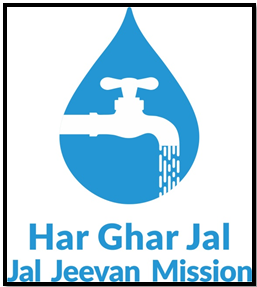PROVIDING CLEAN WATER TO ALL
Relevance:
GS 2
- Government policies and interventions for development in various sectors and issues arising out of their design and implementation.
- Development processes and the development industry —the role of NGOs, SHGs, various groups and associations, donors, charities, institutional and other stakeholders.
Why in News:
Recently, the World Health Organization (WHO) in its study, it highlighted the potential impact of the Jal Jeevan Mission (JJM).
Source- KRWS
In the hilly village of Kyarkuli Bhatta in Uttarakhand, migration has significantly reduced. Similarly, the tribal hamlet of Kusumdith in Jharkhand has witnessed a decline in human-animal conflicts, while weddings in Chandpur village in Maharashtra are once again celebrated with grandeur. The common thread that transformed these regions is the availability of tap water, made possible by the Jal Jeevan Mission, led by Union Minister Gajendra Singh Shekhawat.
Introduction to the Jal Jeevan Mission
- Initiation: Launched by Prime Minister Narendra Modi in 2019, the Jal Jeevan Mission aims to ensure tap water availability in rural households across India.
- Progress: As of now, the mission has successfully provided tap water connections to 73% of rural households, marking a significant rise from the 3.23 crore connections in August 2019.
- Guiding Principle: Operating under the principle of ‘Sabka Saath, Saba Vikas, Sabka Vishwas aur Sabka Prayas’, the mission aligns with the United Nations’ Sustainable Development Goal 6, emphasizing clean water and sanitation for all.
Implementation Strategy
- Objective: The primary goal is to provide piped water in sufficient quantity and quality to every rural household in India, addressing challenges related to water scarcity, health, and hygiene.
- Approach: Acknowledging India’s diverse geographical terrains, the mission focuses on community involvement, collaboration with development partners, and NGOs to strengthen infrastructure.
- Customization: Recognizing the unique needs of different regions, the mission employs specific solutions like insulated pipes in cold regions and community water purification plants where water quality is a concern.
Impact and Benefits
- Socio-Economic Development: The mission not only provides clean water but also aims to fortify the socio-economic fabric of rural communities by promoting community participation and empowering women and youth.
- Health Benefits: Studies, including one by Nobel Laureate Dr. Michael Kremer, highlight significant health benefits, such as the potential reduction in infant deaths and averted diarrhoeal deaths.
- Economic Savings: The provision of safe drinking water is projected to lead to substantial economic savings, with estimates reaching up to $101 billion.
Community Involvement and Skill Development
- Village Water Committees: Over 5.29 lakh village water and sanitation committees have been established, involving about 22.98 lakh women trained in water sample testing.
- Nal Jal Mitra Initiative: A specialized program focusing on equipping villagers with skills for minor repairs and maintenance of water supply schemes.
- Employment Opportunities: The mission is a significant source of employment, generating millions of person-years of direct and indirect employment during construction, operation, and maintenance phases.
Transparency and Efficiency
- Real-Time Dashboard: A dedicated dashboard provides real-time updates and progress reports, ensuring transparency and efficiency in water resource management.
- Water Quality Monitoring: The proactive Water Quality Management Information System enables continuous monitoring, detection, and prompt action in case of water quality issues.
Future Outlook
- Vision: The mission envisions a future where water scarcity is eliminated, and every rural household has access to the essential resource of water.
- Community Engagement: Ongoing efforts to engage communities in managing and maintaining water assets, ensuring sustainable water resource management.
- Policy Implementation: Enhance policy effectiveness through robust monitoring, evaluation, and feedback incorporation.
- Technology Integration: Employ modern technology for improved governance, data management, and service delivery.
- Capacity Building: Focus on training and skill development to strengthen local institutions and community capabilities.
- Public-Private Partnerships: Foster government and private sector collaboration for resource mobilization, innovation, and enhanced service provision.
In summary, the Jal Jeevan Mission stands as a remarkable initiative that not only provides clean water but also empowers rural communities, saves lives, and fosters economic growth while promoting transparency and efficiency in water resource management.
| JMM Performance
· Presently, there are piped water connections in approximately 12.3 crore rural households, which accounts for 62% of households. This marks a substantial increase from the 3.2 crore households, or 16.6%, in 2019. · Five states, namely Gujarat, Telangana, Goa, Haryana, and Punjab, along with three Union Territories—Andaman & Nicobar Islands, Daman Diu & Dadra Nagar Haveli, and Puducherry, have achieved 100% coverage under JJM. · Himachal Pradesh, at 98.87%, and Bihar, at 96.30%, are also on the verge of achieving complete saturation in the near future, indicating significant progress in extending piped water connections to rural areas. |
| Key Highlights of the WHO Study on Jal Jeevan Mission (JJM)
· Averting Diarrhoea Deaths: JJM has the potential to prevent nearly 4 lakh deaths caused by diarrhoea, showcasing the life-saving impact of providing piped potable water to all Indian households. · Avoidance of Disability Adjusted Life Years (DALYs): JJM could help avoid approximately 14 million DALYs associated with diarrhoea. This translates to saving around USD 101 billion and freeing up 66.6 million hours of daily time that would have otherwise been spent, primarily by women, collecting water. DALYs account for years of life lost due to premature mortality (YLLs) and years lived with a disability (YLDs) due to prevalent health conditions in a population. · Gender Equality: The availability of piped water has the potential to promote gender equality by reducing the burden of water collection on women. This, in turn, opens up more opportunities for women in terms of education and employment, enhancing their overall quality of life. |
Source
The Hindu
Mains Question
Q Assess the impact of the Jal Jeevan Mission on socio-economic aspects in rural areas. Discuss the role of community involvement and skill development initiatives under the mission in promoting sustainable development.

 Source- KRWS
Source- KRWS

